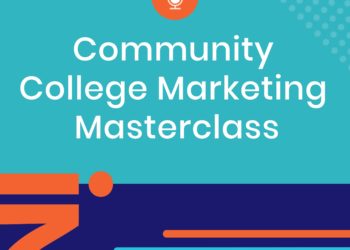
In this episode of the Community College Marketing MasterClass Podcast, Adam Lopez, the Esports Coordinator and coach at Imperial Valley College, joins Interact CEO Dr. Pam Cox-Otto and Student Social… Read More – Esports at Community Colleges
Resources February 12, 2018

Don’t overlook student voices. That’s the message of a new report, based on student focus groups that detailed their community college experiences and their thoughts on Guided Pathways.
Published by the Career Ladders Project, Bringing Student Voices to Guided Pathways Inquiry and Design evolved from 16 focus groups, comprising a total of 137 students, at two mid-size, urban California community colleges. A cross section of students from both schools was queried about the process they encountered in selecting majors and choosing courses, what resources had been helpful and what services they felt were lacking.
Bringing Student Voices to Guided Pathways Inquiry and Design is among the latest in an ongoing series of efforts to ensure that students are heard, as California community colleges move to implement a Guided Pathways framework. To further such endeavors, the non-profit RP Group is developing a “how-to” guide, designed to help colleges meaningfully engage students in the inquiry and design phases and to lay the foundation for ongoing student involvement.
Among the findings detailed in Bringing Student Voices to Guided Pathways Inquiry and Design:
1) Students want more guidance in choosing a major and understanding its connection to various careers. Many students said they were not prepared to identify a major at the beginning of college, because they lacked knowledge about the careers they could attain by pursuing particular majors.
“I know a lot of people who have been here for five or seven years, and they switched their major so many times, and that is why they are here so long,” said one student. “I think that happens so often because there isn’t really someone to sit with them and say: ‘Here, these are your strengths, these are careers that would be really good for you, and these ones aren’t.’ So that’s why they keep jumping around.”
Suggestions included daylong seminars, workshops and career fairs; job shadowing and internship/externship opportunities; a course that provides an overview of different majors and how they link with careers; and guest speakers.
2) Students want clearer course sequencing and improved course availability. Most students who took part in the focus groups said they have sometimes been unable to enroll in a needed class, and had to endure a frustrating waitlist process. Others said the necessary classes sometimes conflicted with work schedules or weren’t offered during the semester they needed to take them. Another common theme revolved around students taking extraneous or unnecessary courses, due to a lack of clarity in degree requirements.
“I found it really hard to find classes because I’m a big fan of not wasting time,” said one student. “So, I was like, ‘I’m not going to take anything I don’t really need to take.’ It was really hard.”
On a brighter note, students in specific career education programs felt that their requirements were clear, and were always able to enroll in needed classes.
3) Awareness of the various available support services is sometimes lacking. Despite the availability of services such as tutoring, degree counseling, learning centers, disability resource centers, transfer and tutoring centers, and more, many students said their college could do a better job in referring and creating awareness of these options.
“People just come in and out, and of course they’re not going to run into these services because they’re not looking at bulletin boards or their email, they’re just trying to get in and out,” noted one student.
4) Students want consistency in the counselors they see, and they want counselors who specialize in their area of interest or major. The study’s authors noted that, although students were not asked specifically about their experiences with counselors, they nevertheless discussed the topic extensively. Experiences ran the gamut, with some students saying their interactions were helpful, and others leveling criticism at the support they received. A common concern was that counselors have limited specialized knowledge in a specific subject area, thus providing little help in career exploration, choosing a major or understanding the content of a particular course.
“I was thinking about the [idea of having] counselors who are almost specialized in a certain area,” said one student. “A counselor for the science department, a counselor for the art department, a counselor for, let’s say, kinesiology.”
5) Students yearn for a sense of community and connection with their peers, and they place a priority on culturally relevant curricula and diversity. Some students discussed their appreciation for learning communities, but many wished the diversity and culturally relevant curricula that were part of their learning communities could be found throughout their college experience.
“I remember the first day of my first English class I was going to sign up for,” said one student. “The teacher asked us: ‘Everyone write down on your paper like what do you want out of class.’ I remember saying: ‘I want to read a book by an author of color, because I never got to do that in high school’… and then (I) saw our books were about some white guy climbing Mount Everest.”
The Career Ladders Project evolved from a 2001 California Community Colleges Board of Governors call for a statewide comprehensive career ladders initiative. Originally titled “Ladders of Opportunity,” the initiative aimed to ensure access to postsecondary career pathways for underserved populations, while meeting workforce needs. Today, the Career Ladders Project operates under the auspices of the non-profit Foundation for Community Colleges, the official auxiliary of the California Community Colleges. Based in Oakland, the Career Ladders Project partners with community colleges to help develop and implement educational and career pathways to ensure that those from disadvantaged populations receive the education and training necessary to find work in high-wage, high-demand careers.

In this episode of the Community College Marketing MasterClass Podcast, Adam Lopez, the Esports Coordinator and coach at Imperial Valley College, joins Interact CEO Dr. Pam Cox-Otto and Student Social… Read More – Esports at Community Colleges


Discovering and understanding your marketing team’s interpersonal needs can potentially help your team be more productive and happier as you ramp up your marketing efforts.